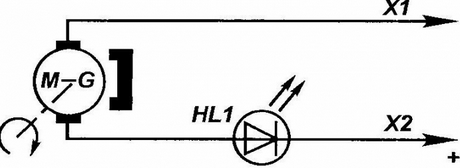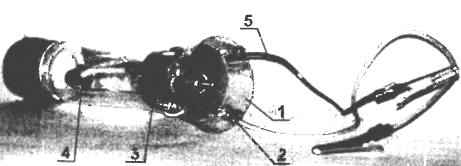Among the devices that are used to test (continuity test) electrical circuits that are not the last place is occupied by the probes. They are simple in design and application. The probe is an indicator, in series with which is connected, as a rule, a galvanic cell (battery), current limiting resistance and two testers. Touching the probes on different portions of the circuit, check the serviceability of all its parts and the accuracy of their connections.
But in addition to electrochemical cells, and other known power sources. Why not apply them in the design of the probe and to make device, for example, working on the basis of electromagnetic induction.
The prospects of this idea was seen, bringing the scheme, much like school demonstration experiment to study the laws of Faraday. Source electricity was multiturn coil (connected in series winding of polarized relay RP-4) is introduced inside a regular "band" magnet 3x3x40, the end of which is connected with a steel spring. As the indicator light coming from the led with a rated current of the glow 20 mA. Probes were two cut flexible bonding wire with vinyl insulation, supplied with clamps type "crocodile".
Of course: if you click on the core-magnet (or a little to pull it out coil), and then let go, the spring will return the electromagnetic system in original position. In the coils have induced EMF is proportional to the rate of change of magnetic flux. When connecting a probe with such power source, for example, a defective diode svetaine-cator will light only when one polarity of the p-p transition. If the flash is in both the polarities, then check the diode is "broken". When outbreaks when no one polarity, means there is internal breakage of the semiconductor device.


Schematic and design of the probe, which has a role in the power source is a... micro motor from a broken electrified toys or cassette recorder: 1 - transparent plastic case (modified bottle of shampoo); 2 - terminal (M4 stud bolts, 2 compl.); 3 - the micro motor; 4 - led; 5 - outlet with clamp type "crocodile" (2 PCs.)
Likewise checked n-p transitions in high-power transistors. Given that the collector of such semiconductor triode is connected to the body, you can see them the Pinout, not having at hand the relevant directory.
After ascertaining the operability of the above construction, became to experiment with other options homemade probe, instead of embedding galvanic cells "non-standard power sources" type phone the primer TK-67-NT or dynamics GD-28. And found that when tap on the cone to voice coil such electromagnetic systems electromotive force occurs that is sufficient for led test electrical chains.
However, it is most convenient to perform the continuity test probe, in which the power supply uses a standard micro motor (for example, from electrified toys or cassette recorder), an employee now generator. In addition, this device differs from the others in simplicity, reliability and originality of the design. Especially if the the case... "upgraded" plastic bottle for shampoo or other household chemicals (see figure). For the probe need only neck from this container with a transparent Central part, which is inserted the series-connected led and source power-micro motor-generator, fastened with studs nuts-terminals. To them and screw the wire with clamps type "crocodile" to connect to the inspected site electrical circuit. If the chain OK, when turning the shaft of the generator having the led flash, you can even see in his peripheral vision.
In conclusion, a small advice to those who decide to make yourself a probe with led indicator and micro motor-generator instead galvanic power source. At the stage of prototyping, you should make sure the correct orientation of the polarity of the led: anode to a "positive" conclusion Converter of mechanical energy (rotation of the rotor in the usual direction, e.g., clockwise) to electric. The shaft desirable to provide a ribbed tip, which can to accommodate the screw cap from the tube of toothpaste.
Author: S. Levchenko






